Abstract
Bovine (BAM) and rat (RAM) alveolar macrophages were incubated in vitro with DQ12 quartz or UICC chrysotile asbestos either alone or in the presence of dipalmitoyl lecithin (DPL). The reaction of the cells of both species to the untreated dust particles was similar qualitatively and quantitatively, with a loss of viability and release of lactate dehydrogenase and N-acetyl-beta-glucosaminidase after 20 hr of incubation. In the presence of DPL, the toxicity of quartz to BAM disappeared completely, whereas the protective influence of the phospholipid was distinctly diminished in the case of RAM. The presence of lavage fluid was less effective than that of pure DPL. There was no protective influence of DPL with asbestos either for BAM or for RAM. The effects of phagocytizable, suspended quartz particles were compared with the effects of the same type of particles fixed on a glass surface to exclude the possibility of phagocytosis. The effect of the suspended particles on the viability and release of enzymes was more pronounced than that of the fixed particles. On the other hand, superoxide anion production was stimulated to a much higher degree by the fixed quartz particles. This could be explained by the continuing contact of the outer cell membrane with the silica surfaces, whereas free particles were rapidly phagocytized. The release of lysosomal enzymes induced by fixed quartz particles was a secondary phenomenon following cell death.
Full text
PDF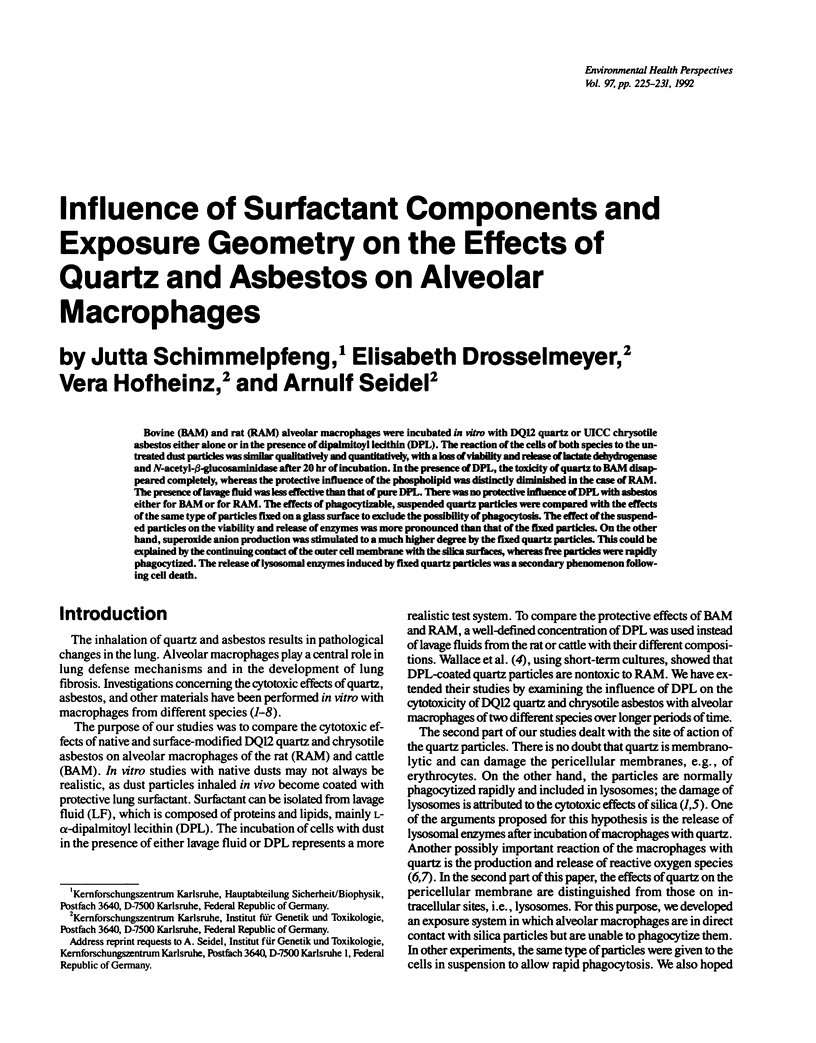
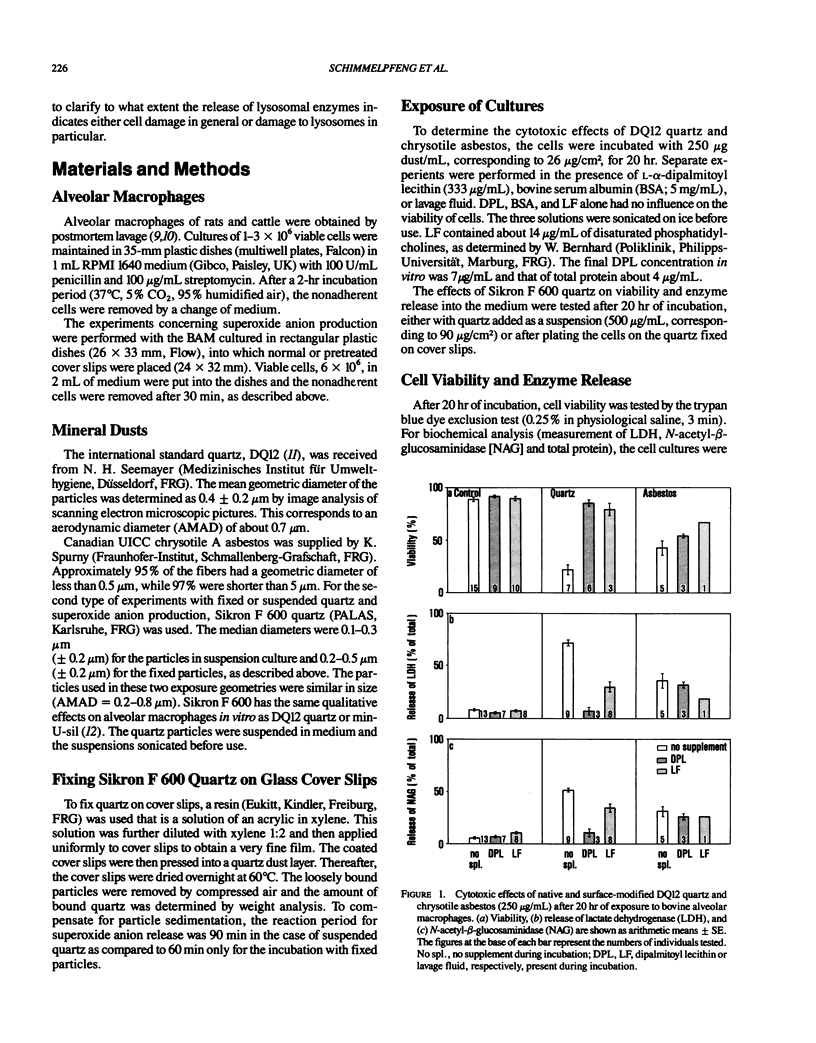
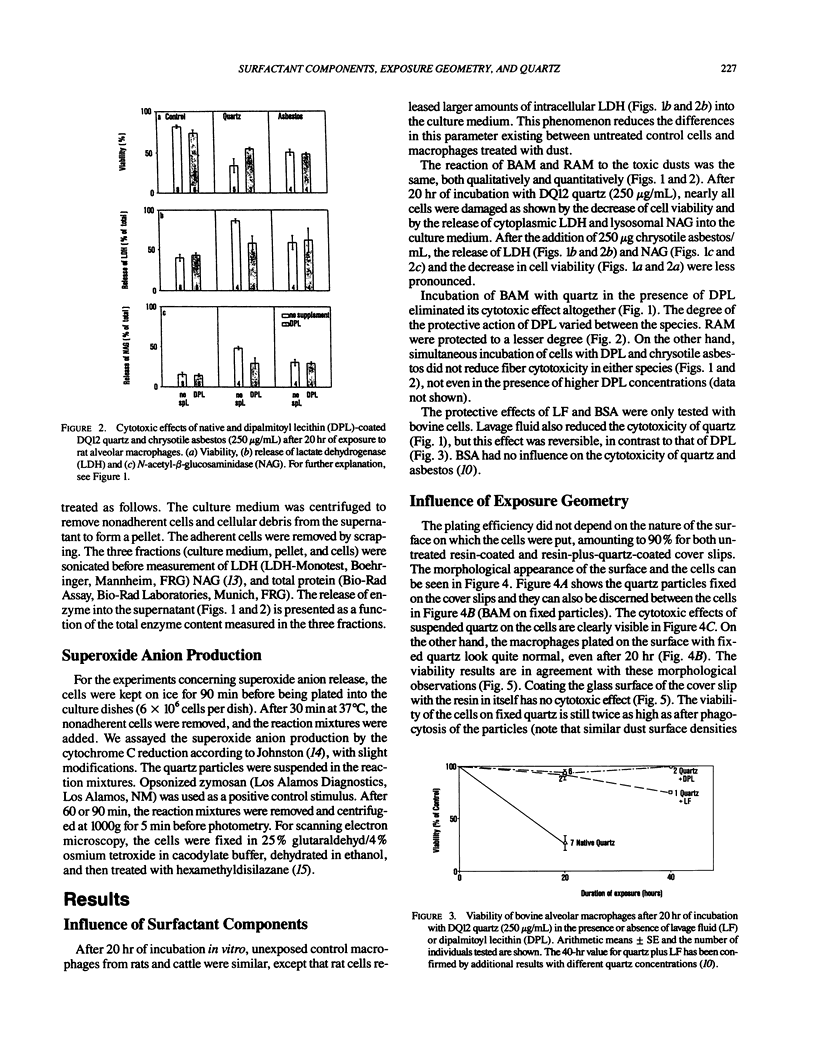
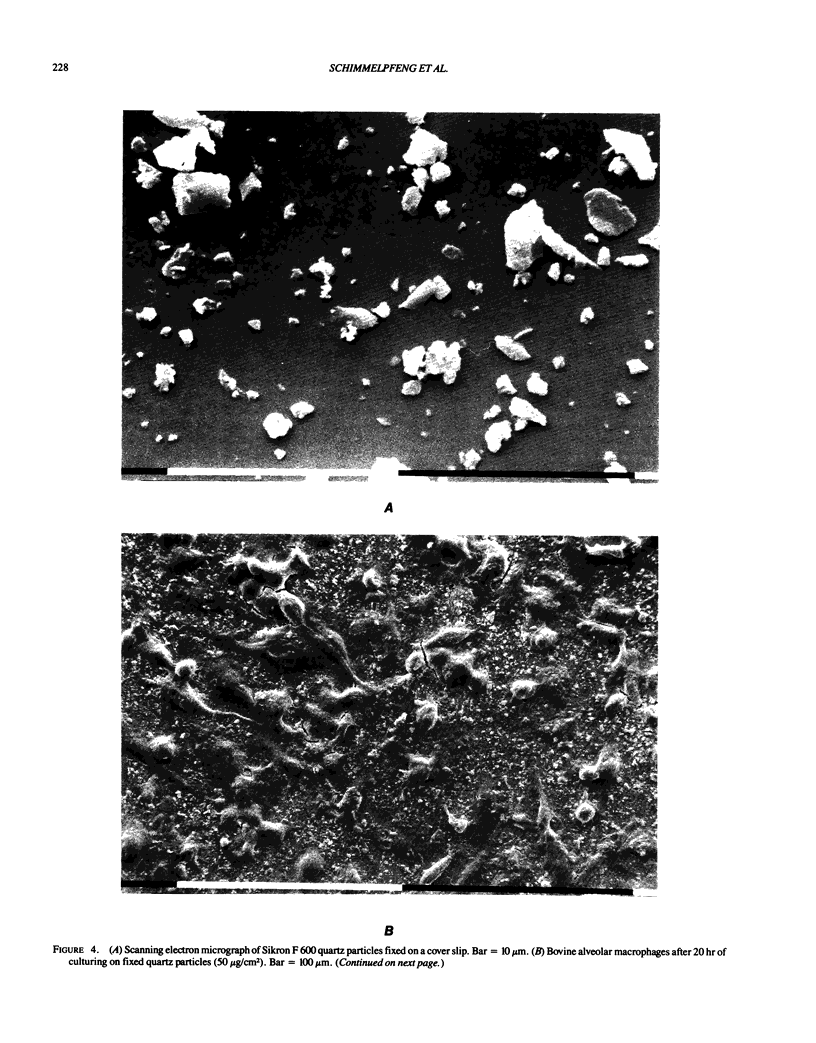
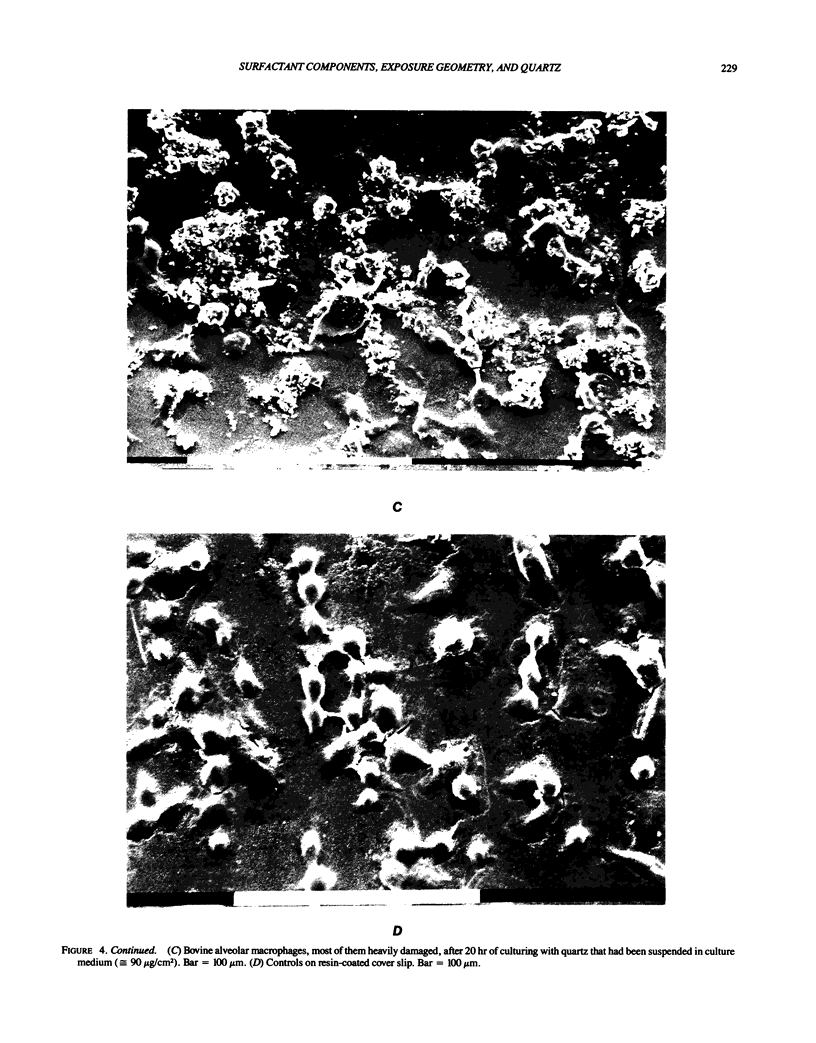
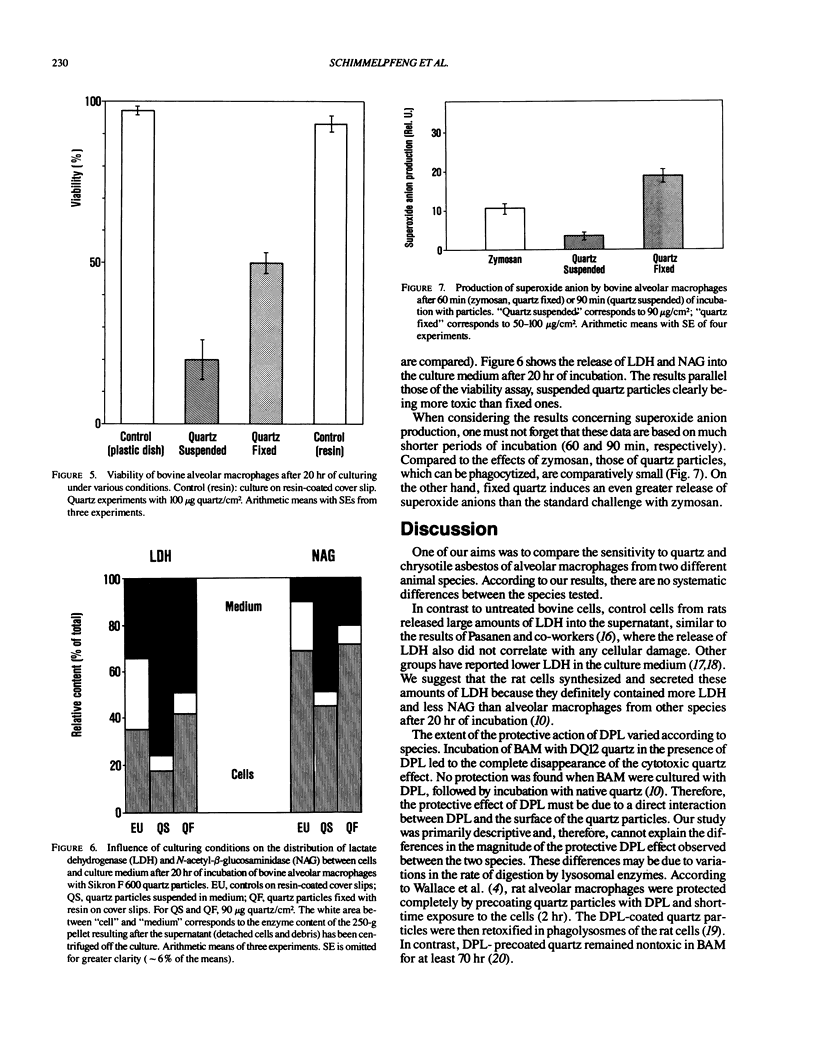
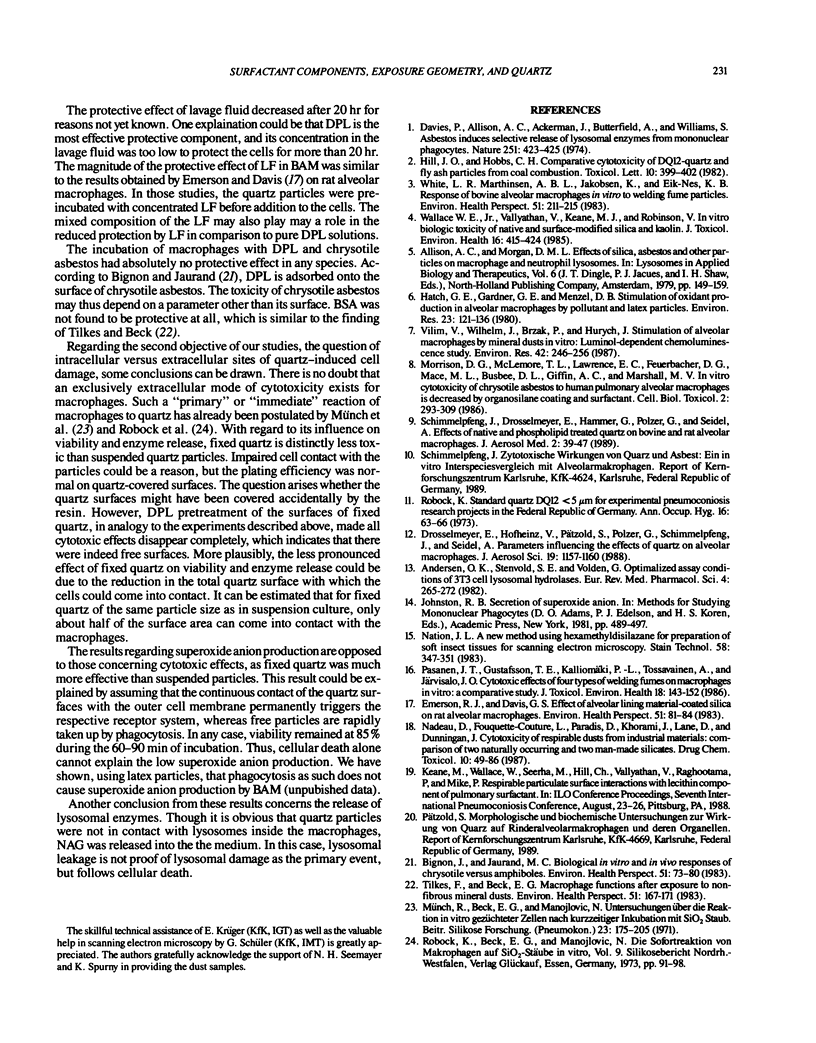
Images in this article
Selected References
These references are in PubMed. This may not be the complete list of references from this article.
- Allison A. C., Morgan D. M. Effects of silica, asbestos, and other particles on macrophage and neutrophil lysosomes. Front Biol. 1979;48:149–159. [PubMed] [Google Scholar]
- Bignon J., Jaurand M. C. Biological in vitro and in vivo responses of chrysotile versus amphiboles. Environ Health Perspect. 1983 Sep;51:73–80. doi: 10.1289/ehp.835173. [DOI] [PMC free article] [PubMed] [Google Scholar]
- Davies P., Allison A. C., Ackerman J., Butterfield A., Williams S. Asbestos induces selective release of lysosomal enzymes from mononuclear phagocytes. Nature. 1974 Oct 4;251(5474):423–425. doi: 10.1038/251423a0. [DOI] [PubMed] [Google Scholar]
- Emerson R. J., Davis G. S. Effect of alveolar lining material-coated silica on rat alveolar macrophages. Environ Health Perspect. 1983 Sep;51:81–84. doi: 10.1289/ehp.835181. [DOI] [PMC free article] [PubMed] [Google Scholar]
- Hatch G. E., Gardner D. E., Menzel D. B. Stimulation of oxidant production in alveolar macrophages by pollutant and latex particles. Environ Res. 1980 Oct;23(1):121–136. doi: 10.1016/0013-9351(80)90099-7. [DOI] [PubMed] [Google Scholar]
- Hill J. O., Hobbs C. H. Comparative cytotoxicity of DQ12-quartz and fly ash particles from coal combustion. Toxicol Lett. 1982 Mar;10(4):399–403. doi: 10.1016/0378-4274(82)90237-5. [DOI] [PubMed] [Google Scholar]
- Morrison D. G., McLemore T. L., Lawrence E. C., Feuerbacher D. G., Mace M. L., Jr, Busbee D. L., Griffin A. C., Marshall M. V. In vitro cytotoxicity of chrysotile asbestos to human pulmonary alveolar macrophages is decreased by organosilane coating and surfactant. Cell Biol Toxicol. 1986 Jun;2(2):293–309. doi: 10.1007/BF00122697. [DOI] [PubMed] [Google Scholar]
- Münch R., Beck E. G., Manojlović N. Untersuchungen über die Reaktion in vitro gezüchteter Zellen nach kurzzeitiger Inkubation mit SiO 2 -Staub. Beitr Silikoseforsch Pneumokoniose. 1971;23(4):173–205. [PubMed] [Google Scholar]
- Nadeau D., Fouquette-Couture L., Paradis D., Khorami J., Lane D., Dunnigan J. Cytotoxicity of respirable dusts from industrial minerals: comparison of two naturally occurring and two man-made silicates. Drug Chem Toxicol. 1987;10(1-2):49–86. doi: 10.3109/01480548709042583. [DOI] [PubMed] [Google Scholar]
- Nation J. L. A new method using hexamethyldisilazane for preparation of soft insect tissues for scanning electron microscopy. Stain Technol. 1983 Nov;58(6):347–351. doi: 10.3109/10520298309066811. [DOI] [PubMed] [Google Scholar]
- Pasanen J. T., Gustafsson T. E., Kalliomäki P. L., Tossavainen A., Järvisalo J. O. Cytotoxic effects of four types of welding fumes on macrophages in vitro: a comparative study. J Toxicol Environ Health. 1986;18(1):143–152. doi: 10.1080/15287398609530855. [DOI] [PubMed] [Google Scholar]
- Robock K. Standard quartz dq12 greater than 5 micro m for experimental pneumoconiosis research projects in the Federal Republic of Germany. Ann Occup Hyg. 1973 Apr;16(1):63–66. doi: 10.1093/annhyg/16.1.63. [DOI] [PubMed] [Google Scholar]
- Tilkes F., Beck E. G. Macrophage functions after exposure to nonfibrous mineral dusts. Environ Health Perspect. 1983 Sep;51:167–171. doi: 10.1289/ehp.8351167. [DOI] [PMC free article] [PubMed] [Google Scholar]
- Vilím V., Wilhelm J., Brzák P., Hurych J. Stimulation of alveolar macrophages by mineral dusts in vitro: luminol-dependent chemiluminescence study. Environ Res. 1987 Feb;42(1):246–256. doi: 10.1016/s0013-9351(87)80026-9. [DOI] [PubMed] [Google Scholar]
- Wallace W. E., Jr, Vallyathan V., Keane M. J., Robinson V. In vitro biologic toxicity of native and surface-modified silica and kaolin. J Toxicol Environ Health. 1985;16(3-4):415–424. doi: 10.1080/15287398509530751. [DOI] [PubMed] [Google Scholar]
- White L. R., Marthinsen A. B., Jakobsen K., Eik-Nes K. B. Response of bovine alveolar macrophages in vitro to welding fume particles. Environ Health Perspect. 1983 Sep;51:211–215. doi: 10.1289/ehp.8351211. [DOI] [PMC free article] [PubMed] [Google Scholar]






